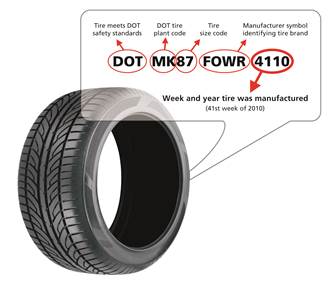When it comes to determining the age of a tire, it is easiest to identify when the tire was manufactured by reading its Tire Identification Number (often referred to as the tire’s serial number or DOT number). Unlike vehicle identification numbers (VINs) and the serial numbers used on many other consumer goods (which identify one specific item), Tire Identification Numbers are really batch codes that identify several components.
Thank you for reading this post, don't forget to subscribe!The U.S. Department of Transportation (DOT) National Highway Traffic Safety Administration (NHTSA) requires that Tire Identification Numbers be a combination of the letters DOT, followed by ten, eleven or twelve letters or numbers that identify the manufacturing location, tire size and manufacturer’s code, along with the week and year the tire was manufactured.
Tires Manufactured Since 2000– Since the year 2000, the week and year the tire was produced has been provided by the last four digits of the Tire Identification Number. Of those last four digits, the first two identify the week of the year that the tire was made while the last two identify the year itself. Here is an example of a tire manufactured since 2000 with the current Tire Identification Number format: DOT U2LL LMLR 5109 51 Manufactured during the 51st week of the year 09 Manufactured during 2009 While the entire Tire Identification Number is required to be branded onto one sidewall of every tire, current regulations also require that DOT and the first digits of the Tire Identification Number must also be branded onto the opposite sidewall. Therefore, it is possible to see a Tire Identification Number that appears incomplete and requires looking at the tire’s other sidewall to find the entire Tire Identification Number. Tires Manufactured Before 2000– The Tire Identification Number for tires produced before the year 2000 was based on the assumption that tires would not be in service for ten years. While they were required to provide the same information as today’s tires, the week and year the tire was produced was contained in the last three digits. The 2 digits used to identify the week a tire was manufactured immediately preceded a single digit used to identify the year.
An example of a tire manufactured before 2000 with the earlier Tire Identification Number format:
DOT EJ8J DFM 328
32 Manufactured during the 32nd week of the year
8 Manufactured during the 8th year of the decade- i.e. 1998
While the previous Tire Identification Number format identified that a tire was built in the 8th year of a decade, there was no universal identifier that confirmed which decade (tires manufactured in the 1990s may have a small triangle following the Tire Identification Number to identify the decade).
When in doubt, you can also check your records or receipts. Most tire manufacturer’s warranties cover their tires for four to five years from the date of purchase or five years from the week the tires were manufactured (This can and may differ from the different manufacturers). So if you purchase new tires that were manufactured exactly two years ago they will be covered for a total of six years (four years from the date of purchase) as long as you have your receipt. If you lose your receipt, your tires’ warranty coverage will usually end five years from the week the tire was produced.


